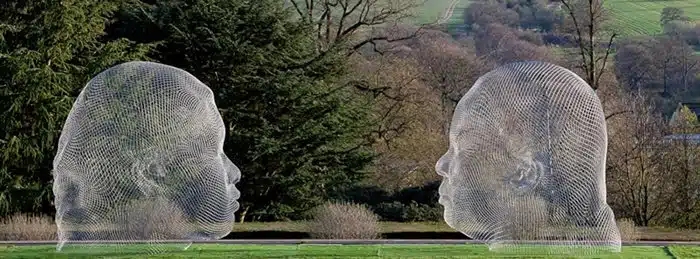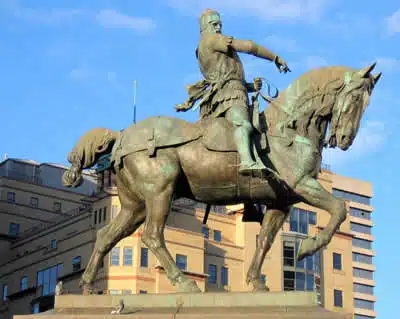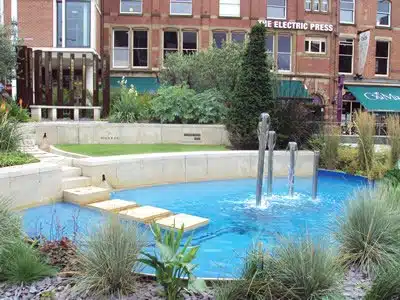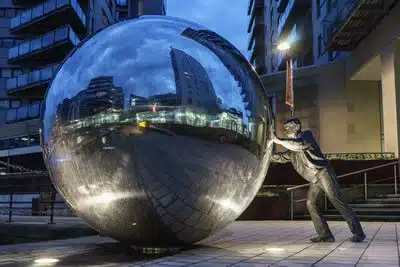West Yorkshire sculpture has been given a great boost this year with the opening of the Hepworth Gallery in Wakefield, just a fifteen minute train-ride from the centre of Leeds. The Hepworth has had the London art media flocking north, and enhances the region’s reputation as a sculpture heartland.
Yorkshire Sculpture Park
The Yorkshire Sculpture Park at Bretton is just a short way down the M1, after all, and two of England’s best-known sculptors – Barbara Hepworth, after whom the Hepworth is named, and Henry Moore – were born nearby (in Wakefield and Castleford, respectively).
Leeds City Art gallery
But you don’t need to travel to Bretton or Wakefield to enjoy great sculpture. Leeds City Art Gallery houses a number of fascinating works by artists including Moore, Hepworth, Auguste Rodin and Anthony Gormley, while the Henry Moore Institute next door is entirely devoted to sculpture.
The fact is, you can see some fantastic pieces without even going inside: Moore’s monumental bronze Reclining Woman (1981) can be found lounging permanently at the top of the gallery steps.
 Black Prince in the city square
Black Prince in the city square
Elsewhere in the city, the public statuary ranges from the traditional to the downright quirky. The grand figures of the Black Prince in the City Square, Carlo Marochetti’s Duke of Wellington in Hyde Park and William Behnes’ Robert Peel on Woodhouse Moor certainly fall into the former category – even if Wellington’s boots have been mischievously painted bright red.
The Barrelman
In the city centre, statues can be found behaving in rather more unexpected ways. In Dortmund Square, at one of the busiest junctures of the Headrow, the indefatigable ‘Barrelman’ eternally hefts a keg of beer.
The Barrelman was a gift to Leeds from the German city of Dortmund – danke, Dortmund! – and has been in his current spot since 1980. A few years ago, local artist Tom Pultney temporarily swathed the Barrelman in red-and-white barrier tape to create a new artwork, which he called Barred.
The Continental Connection
Tucked away in Bond Court, meanwhile, a set of bronzes provides another continental connection. Roger Burnett’s 2000 sculpture group depicts a family watching a man play the French game boules (a variation on English bowls).
The gravel area next to the sculptures is in fact a usable boules court – so, if you fancy, you can interrupt your sculpture tour for a set or two.
 Mandela Gardens
Mandela Gardens
At the western end of the Headrow, the Mandela Garden in Millennium Square is home to a striking bronze in the Moore tradition. William Armitage’s Both Arms depicts a vast pair of green-banded arms, outstretched imploringly.
Hidden Gem of Sculpture
A still more extraordinary creation can be found in a neglected courtyard around the back of the Merrion Centre, just off Claypit Lane. A real hidden gem for sculpture buffs, Glenn Hellman’s Androgyne was the result of a national competition for a piece of art to occupy the site.
It’s a strange, unsettling, abstract piece, cast in aluminium (not, as many sources claim, fibreglass) – and it’s a real shame that such an original work is so hard to find.
 Champion Leeds Sculpture
Champion Leeds Sculpture
Rather more noticeable is a recent work that you’ll have to head a little way out of the city centre to see. Clare Bigger’s Triumphant is more dramatic than its bland, businesslike setting – the Leeds Valley Business Park, south-east of the city – might lead you to expect.
Six metres high and sculpted from gleaming stainless steel, the unmissable piece depicts a champion runner celebrating a victory lap. It’s vivid and graceful enough to make you forget its corporate background.
Greek myth Sisyphus
Returning again from the monumental to the distinctly quirky, Kevin Atherton’s A Reflective Approach is another work that brings much-needed style and charm to a modern urban development.
Located at Clarence Dock, the site of the Royal Armouries, the sculpture depicts two men pushing uselessly at two enormous mirrored balls. The piece recalls the Greek myth of Sisyphus, who was condemned to push a boulder up a slope for all eternity. Atherton’s work, like many others in Leeds, is a reminder that finding fascinating public art in Leeds needn’t be an uphill task.
More Information
If you would like additional ideas for things to do in Leeds, why not take a look at more of the attractions and events in our other Leeds guides.


 Black Prince in the city square
Black Prince in the city square Mandela Gardens
Mandela Gardens Champion Leeds Sculpture
Champion Leeds Sculpture